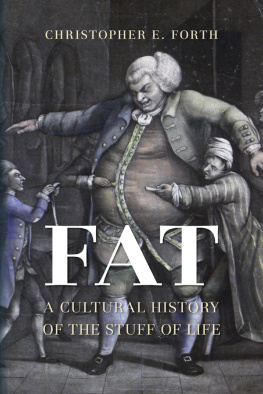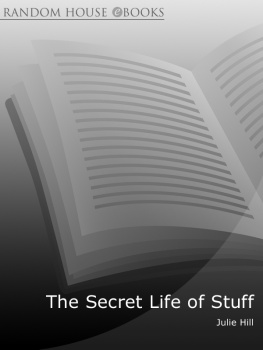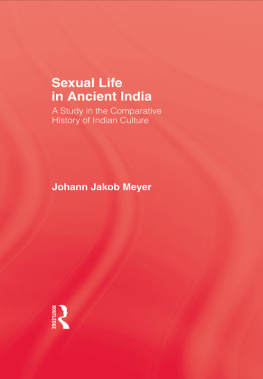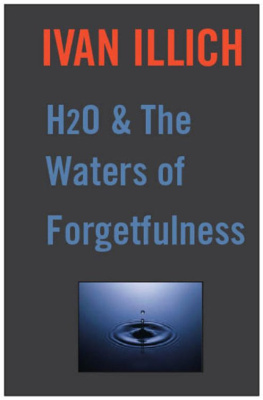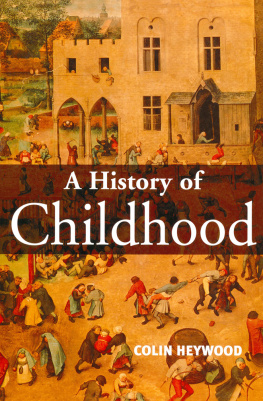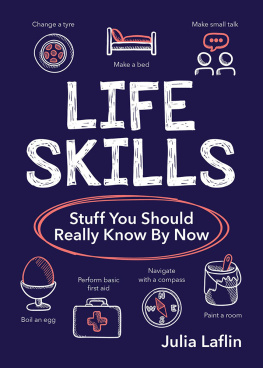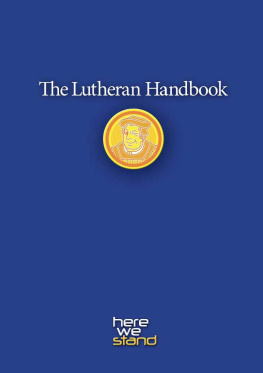FAT

FAT
A CULTURAL HISTORY
OF THE STUFF OF LIFE
Christopher E. Forth
REAKTION BOOKS
For Sarah Trulove, a long answer to a good question!
Published by Reaktion Books Ltd
Unit 32, Waterside
4448 Wharf Road
London N1 7UX, UK
www.reaktionbooks.co.uk
First published 2019
Copyright Christopher E. Forth 2019
All rights reserved
No part of this publication may be reproduced, stored in a retrieval system, or transmitted, in any form or by any means, electronic, mechanical, photocopying, recording or otherwise, without the prior permission of the publishers
Page references in the Photo Acknowledgements and
Index match the printed edition of this book.
Printed and bound in Great Britain by TJ International, Padstow, Cornwall
A catalogue record for this book is available from the British Library
eISBN 9781789140965
CONTENTS
INTRODUCTION:
Life in the Wrong Place
F at. The word conjures a range of images and evokes a multitude of feelings. Some of the these are positive. A fat body can appear beautiful and desirable. It may take up space in ways that are empowering and intimidating; it may also suggest an ability to enjoy abundance that other people cannot. Soft fat may feel comforting, sensual even, in ways that bony slenderness rarely does. At its best, fat may suggest the swollen fullness of life itself. In our current world, however, these positive impressions are often eclipsed by more negative ones. In medicine and the media, as well as in much scholarly and activist writing on the subject, the word fat is usually considered in terms of its accumulation in the body in the form of obesity, which may be criticized on aesthetic and/or medical grounds and which is often the target of discrimination. Among those seeking to understand how large bodies have been stigmatized in recent years, a common-sense equation of fat with corpulence or fatness Regardless of where one stands on the issue, these facts seem to be more or less straightforward.
There is also no shortage of explanations for why these developments unfolded as they did. Here, too, scholarship on the subject reflects some broadly shared assumptions. When it comes to thinking about fat appreciation, a geographic division between the West and the Rest is not only taken for granted, but is subdivided by a temporal one within Western culture. Several scholars demonstrate a distinction between a pre-modern acceptance of fat as a sign of health, fertility and beauty, and a modern rejection of what is often now labelled obesity as unhealthy, disgusting and connected to the poor.
From this perspective, fat is an instance of what anthropologist Mary Douglas described as matter out of place in an ordered cultural system of ideas and images about health and beauty.
More slippery than many assume, fat exceeds the frames used to contain it conceptually. One doesnt need to look far to see the complex visceral responses that fat can elicit in the twenty-first century. Consider, for instance, how many of these are condensed in one vivid scene from Joyce Carol Oatess novel Middle Age: A Romance (2001). Here the protagonist Roger encounters a seedy lawyer named Reginald Boomer Spires, a 135-kilo/300-lb man whose obese, doughy-oily flesh was ensconced in a shabby office, his body and surroundings proof of his fallen professional and corporeal status. At first glance this seems like a classic case of fatness symbolizing downward mobility.
This fictional encounter encapsulates some of the revulsion that is widely reported in perceptions of fat today. If one were forced to come up with a six-word explanation for the otherwise inexplicable ferocity of Americas war on fat, Paul Campos writes in The Obesity Myth, it would be this: Americans think being fat is disgusting. It really is, on the most important cultural and political levels, as simple as that. There is ample evidence to confirm this observation. Not only is disgust at fatness widely registered in the media and popular culture, but numerous studies in a variety of countries reveal considerable anti-fat bias among healthcare professionals, who cite a patients ugliness as well as lack of willpower and non-compliance with medical advice as the main reasons for the distaste and contempt they often fail to conceal.
Campos is right about the similarities between anti-fat attitudes and other forms of prejudice. But those who study disgust concur that sight is not paramount in this complex emotion. Summing up the findings of anthropologists and psychologists, the philosopher Martha Nussbaum points to the central role of touch in the generation of disgust. This is because the key idea is that of crossing a boundary from the world into the self. As such,
disgust would thus be closely connected to all three of the senses that the philosophical tradition regards as tactile senses rather than mediated or distance senses: i.e., touch, smell, and taste, rather than sight or hearing.
From this perspective, disgust is a response to the actual or anticipated contact with something material. Psychologists and philosophers studying disgust also tend to agree that, at its heart, this emotion is mobilized by unpleasant, perhaps intolerable, reminders of animality (or creatureliness) and mortality. Cohering most strongly around the activities of eating, sex and defecation, as well as our fragile body envelopes that, when breached, reveal blood and soft viscera, the cognitive structure of disgust relies on a form of magical thinking that denies the realities of impermanence and decay as necessary parts of organic life:
Disgust... wards off both animality in general and the mortality that is so prominent in our loathing of our animality... The products that are disgusting are those that we connect with our vulnerability to decay and to becoming waste products ourselves.
The structure of disgust is inherently idealist, almost utopian. Colin McGinn even calls it a philosophical emotion in which we take the measure of the disjunction between how the world actually works and how we would like it to be.
Despite this talk of death and decay, at the heart of disgust is not a reaction to mortality in which the person faces eventual non-existence. This is because life that is, organic life entails generative vital processes that precede and do not cease with the death of the Historian William Miller concurs:
What disgusts, startlingly, is the capacity for life, and not just because life implies its correlative death and decay: for it is decay that seems to engender life. Images of decay imperceptibly slide into images of fertility and out again. Death thus horrifies and disgusts not just because it smells revoltingly bad, but because it is not an end to the process of living but part of a cycle of eternal recurrence.
If disgust is a response to the often-unpleasant facts of organic life and human embodiment, then perhaps disgust at fat is elicited by a similar set of concerns. The grounds for making such a suggestion become firmer when we consider how often fat itself has been historically associated with vitality, fertility and creatureliness, even to the point of being described as the very stuff of life. In this sense, disgust at fat materializes ambivalence about the fact that humans are embodied as well as misgivings about the wider material world to which those bodies belong. As Miller puts it:
ultimately the basis for all disgust is us that we live and die and that the process is a messy one emitting substances and odors that make us doubt ourselves and fear our neighbors.

